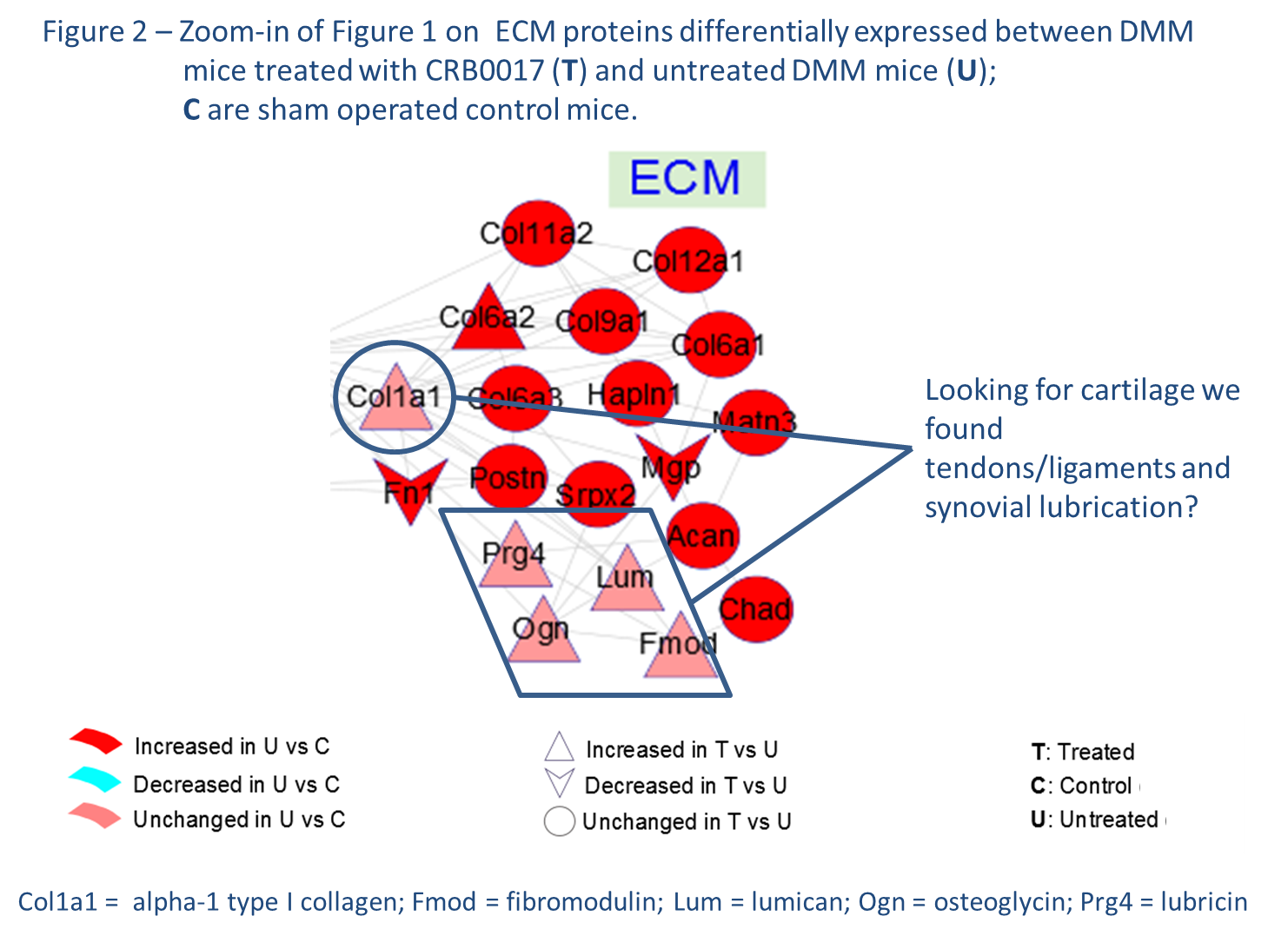Session Information
Date: Monday, November 9, 2015
Title: Biology and Pathology of Bone and Joint Poster I: Osteoarthritis Pathogenesis
Session Type: ACR Poster Session B
Session Time: 9:00AM-11:00AM
Background/Purpose : CRB0017 is a novel therapeutic monoclonal antibody that recognizes the spacer domain of aggrecanase-2, a key enzyme in the degradation of extracellular matrix (ECM) in osteoarthritis (OA). CRB0017 showed a marked cartilage protection in different models of OA in rodents (accompanying abstract by Caselli et al). Because CRB0017 does not recognize the catalytic domain of aggrecanase-2 and, therefore, does not simply inhibit the cleavage of aggrecan, its molecular mode of action on ECM proteins is not fully understood. So, we performed the proteomics analysis of histological samples derived from a surgical model of OA, the Destabilization of Medial Meniscus (DMM) in mice, in which intra-articularly injected CRB0017 had markedly counteracted cartilage degradation (in vivo results in the accompanying abstract by Caselli et al).
Methods : DMM was performed in C57BL/6J mice (10 weeks old at surgery; CRB0017 injection [72 µg in 4 µL] 1 week after surgery, injection repeated after 1 and 2 months, sacrifice at 3 months). At sacrifice, the femorotibial joints were explanted and processed for histology. Histological samples in paraffin from sham, DMM vehicle and DMM CRB0017 mice (9 samples/group) were processed for proteomics analysis. Briefly, samples were deparaffinized, trypsinized and analyzed by LC-MS, and lists of identified proteins were evaluated by MAPROMA cluster and network analyses.
Results : About 400 proteins were identified, and the differential proteomics analysis of sham and DMM animals revealed the expected changes (i.e. general increase in ECM protein turnover, as depicted in Figure 1), confirming the validity of the selected protocol.
The differential analysis between DMM mice treated with vehicle or CRB0017 revealed that the latter affected a series of proteins that have not been associated so far with aggrecanase-2 activity. In particular, (as shown in the enlarged particular in Figure 2) CRB0017 seems to preserve a homogeneous class of ECM proteins, the small leucine-rich repeat proteoglycans (SLRPs) fibromodulin, lumican and osteoglycin, and the levels of lubricin, one the most relevant components of joint lubrication.
Conclusion : Proteomics analysis of histological samples from joints of DMM mice treated with CRB0017 revealed that this monoclonal antibody against the spacer domain of aggrecanase-2 can modulate a series of proteins whose association with aggrecanase has not been codified yet (besides fibromodulin), but whose contribution to OA progression is well documented. These data, therefore, point out a new potential mode of action for therapeutic anti-aggrecanase antibodies.
To cite this abstract in AMA style:
Caselli G, Chiusaroli R, Visintin M, Piepoli T, Letari O, Grotti A, Lanza M, De Palma A, di Silvestre D, Mauri P, Rovati LC. The Proteomic Profile of Histological Samples Derived from a Surgical Mouse Model of Osteoarthritis Reveals an Unexpected Mode of Action for the Anti-Aggrecanase-2 Monoclonal Antibody CRB0017 [abstract]. Arthritis Rheumatol. 2015; 67 (suppl 10). https://acrabstracts.org/abstract/the-proteomic-profile-of-histological-samples-derived-from-a-surgical-mouse-model-of-osteoarthritis-reveals-an-unexpected-mode-of-action-for-the-anti-aggrecanase-2-monoclonal-antibody-crb0017/. Accessed .« Back to 2015 ACR/ARHP Annual Meeting
ACR Meeting Abstracts - https://acrabstracts.org/abstract/the-proteomic-profile-of-histological-samples-derived-from-a-surgical-mouse-model-of-osteoarthritis-reveals-an-unexpected-mode-of-action-for-the-anti-aggrecanase-2-monoclonal-antibody-crb0017/


